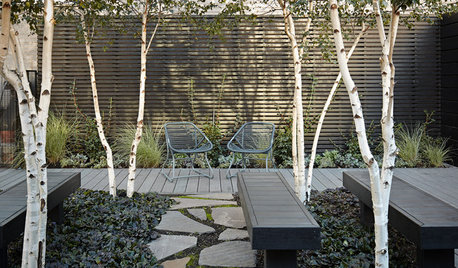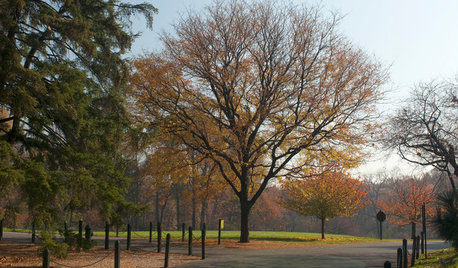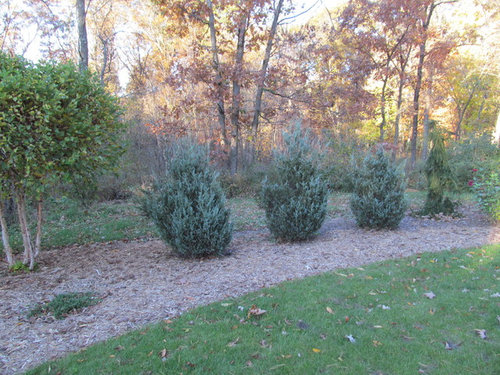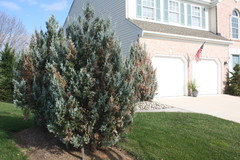Columnar tree recommendation
maackia
8 years ago
Featured Answer
Sort by:Oldest
Comments (33)
edlincoln
8 years agoToronado3800 Zone 6 St Louis
8 years agoRelated Discussions
Columnar apples and other fruit trees
Comments (0)Hi, I've been looking for new varieties of columnar apples and keep seeing the same trees: Golden Sentinel, Northpole, Scarlet Sentinel, and the Stark Bros equivalents. Anyone know of any really new developments in columnar apples and other fruit? Also, for those that have grown the above mentioned varieties, which would you recommend in terms of overall appearance. At my local nursery I noticed that Northpole and Scarlet Sentinel's leaves were more stunted and crowded than Golden Sentinel. Thought that was interesting. I bought Golden Sentinel because I thought the leaves and overall shape were more pleasing. Would love to hear opinions from other people....See MoreColumnar Apple Trees
Comments (3)Use myclobutanil (spectracide Immunox) for Cedar apple rust prevention. BIG thing is prevention not control. You need to apply before you get the disease. This will also prevent apple scab too if that is part of the problem. Captan 50 WP is also a good fungicide to prevent apple scab. Available online. Growing columnar,standard, dwarf or espalier apples should not make a difference as far as disease control. Granted, some apple varieties are more prone to scab than others but the prevention (use a fungicide) will apply to all. Without pictures unable to tell what exact problems your apples are having. Unsprayed apples in my area get scab, cedar-apple rust (if junipers nearby), fireblight, sooty blotch ect. Very hard to get good fruit without spraying to prevent fungal issues. Or you could bag the fruits (paper, plastic, cloth bags) to grow them organically....See Morecolumnar oak trees, arborvitae
Comments (7)Searching the Sheridan Plant Finder I linked to above for "Evergreens" and "Columnar" I got this result showing 12 kinds. http://www.sheridannurseries.com/plant_product_refine_search#P;DA6;...See MoreColumnar European Hornbeam or Columnar Oak or something else?
Comments (10)Even one of those sweetgums (post immediately preceding this one) would not fit in the space discussed and still allow room to walk by. Otherwise there's a pyramidal European hornbeam in the county east of mine that could be 40' across, nearby the USDA station had a 'Frans Fontaine' hornbeam that was about 20' wide and so on. ("Had" because they cut it down recently, maybe because it was thought to have overwhelmed the planting site because it didn't stay skinny). Instead of columnar with branches coming low look for dwarf on a long single stem - from the perspective of your second picture all you need is a comparatively small bushy top at the level of the window. Dwarf hornbeam, dwarf crabapple, naturally small growing maple species - whatever you kind find. In either case (tall and narrow or lollipop/mushroom shaped) it's going to grow sideways over the neighbor's lot - so you need to be prepared for that. As in discussing it with them beforehand, so that you don't have an unpleasant surprise later - just as you are finally getting the coverage out of it you want (tree plantings take years to size up). A surprise as in one day you look at it and all of their side has been cut back to the fence - or even a couple feet back into your lot. (At my previous house a neighbor reached over a fence, cut a screening planting I had put in - that I thought they would appreciate being between them on their patio and my back windows - off at fence height apparently as far as they could reach into my lot. When I had occasion to discuss this unauthorized action with them later the complaint was the living screen was dropping dead leaves on their bark mulch)....See Moremaackia
8 years agoEmbothrium
8 years agoOnline Seminars
8 years agomaackia
8 years agoEmbothrium
8 years agolast modified: 8 years agosam_md
8 years agoEmbothrium
8 years agopennlake
8 years agowaynedanielson
8 years agomaackia
8 years agolast modified: 8 years agoedlincoln
8 years agomaackia
8 years agolast modified: 8 years agolaceyvail 6A, WV
8 years agowaynedanielson
8 years agogardener365
8 years agobengz6westmd
8 years agogardener365
8 years agomaackia
8 years agopennlake
8 years agolaceyvail 6A, WV
8 years agoSelect Landscapes of Iowa
8 years agogardener365
8 years agobengz6westmd
8 years agolast modified: 8 years agomaackia
8 years agowisconsitom
8 years agosam_md
8 years agomaackia
8 years agoNHBabs z4b-5a NH
8 years agolast modified: 8 years agowisconsitom
8 years ago
Related Stories

SIDE YARD IDEASNarrow Trees for Tight Garden Spaces
Boost interest in a side yard or another space-challenged area with the fragrance and color of these columnar trees
Full Story
LANDSCAPE DESIGNPretty Trees for Patios, Paths and Other Tight Spots
Choose trees for their size, shape and rate of growth — or shape them to fit your space. Here's how to get started
Full Story
SPRING GARDENING7 Spectacular and Practical Spring-Flowering Trees
Put on a beauteous show in the garden with a landscape tree awash in flowers — just do your homework first
Full Story
LANDSCAPE DESIGN5 Ways to Use Trees to Create a Sensational Garden Space
Trees define spaces in multiple ways and bring a layer of shade and intrigue to the landscape
Full Story
GARDENING GUIDESWhen and How to Plant a Tree, and Why You Should
Trees add beauty while benefiting the environment. Learn the right way to plant one
Full Story
GARDENING GUIDESGrow Your Own Privacy: How to Screen With Plants and Trees
Use living walls to lower your home and garden's exposure while boosting natural beauty in your landscape
Full Story
GARDENING GUIDESTree Care: Common Tree Diseases and What to Do About Them
Learn to recognize trees that may be affected by diseases or pests so you can quickly take action
Full Story
GARDENING GUIDESHow to Keep Your Trees Healthy
Ensure your trees’ vigor for years to come with these tips for protecting roots, watering effectively and more
Full Story
GARDENING GUIDESGreat Design Plant: Honey Locust Tree
No, it doesn't actually produce honey. But its dappled light and tolerant nature are treats in city and country settings alike
Full Story
EDIBLE GARDENSHow to Grow 10 Favorite Fruit Trees at Home
Plant a mini orchard in fall, winter or early spring to enjoy fresh-off-the-tree fruit the following year
Full Story








gardener365